|
za mart 2005 goda.
 S by SE
S by SE
31.03.2005 | Lunnoe foto dnya
The region near the lunar south pole is often observed because of the attractions of its tall mountains and shadow-shrouded craters. But away from the pole, especially sliding along the limb to the east are less familiar sights with craters that few of us could easily name.
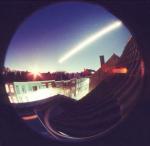 A Looong Lunar Exposure
A Looong Lunar Exposure
30.03.2005 | Lunnoe foto dnya
The Moon is the brightest object in the night sky and sometimes imagers have a hard time getting a short enough exposure. But this image is 6 hours long! The Moon is clearly overexposed but not too much as it traces its nightly movement across the sky of the Belgium city of Ghent.
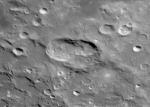 Mee Too!!
Mee Too!!
29.03.2005 | Lunnoe foto dnya
The Moon is a messy target. An incoming projectile has only about a 17% chance of striking a relatively flat area; most impacts occurred on top of existing craters. This causes uneven ejecta distribution and even low spots in the new craters rim where it cuts into the older crater.
 Hungarian Moon
Hungarian Moon
28.03.2005 | Lunnoe foto dnya
Hungarian Moon maps? How about Hungarian maps of Mercury, Venus, Mars and Earth too? All down-loadable and free? The Cosmic Materials Space Research Group Planetology Circle of the EZhtvZhs LorAnd University in Hungary has an active planetary science research program that includes producing maps for educational use.
 New Lunar Maps!
New Lunar Maps!
27.03.2005 | Lunnoe foto dnya
Have you been observing Orientale during this favorable libration? Have you had trouble identifying craters and basin rings in this limb-scrunched region? If so, here is a map that can help you. This is a piece of a new lunar map of the hemisphere centered at 120 degrees West longitude.
 A Long Crater
A Long Crater
26.03.2005 | Lunnoe foto dnya
Schiller is not the largest crater on the Moon but it is probably the least circular. Its length of 180 km and width of 70 km implies that it has had an unusual origin, as discussed in a previous LPOD. In this high resolution image we can examine more closely Schillers interior and surroundings.
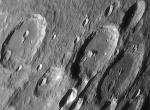 Can You Names These Craters?
Can You Names These Craters?
25.03.2005 | Lunnoe foto dnya
You know the Moon. You have observed it for years, and perhaps imaged nearly every part. So which craters are these? Probably only 1-2 percent of the nearly 2000 daily visitors to LPOD can identify the three large ones (from left to right) as Pitiscus, Vlacq and Rosenberger, near the southeastern limb.
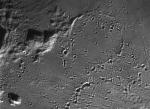 Floods and Buckshot
Floods and Buckshot
24.03.2005 | Lunnoe foto dnya
Stadius is one of the Moons most famous odd formations. Long ago it was said to be a ring of pits, almost certainly of volcanic origin. But even a casual glance reveals that is an inaccurate description and an unjustified interpretation.
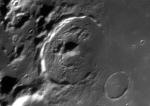 Doppelmayer Surprises
Doppelmayer Surprises
23.03.2005 | Lunnoe foto dnya
Craters we don't look at carefully sometimes hold secrets! Here is an excellent image of the floor-fractured crater Doppelmayer on the southern shore of Mare Humorum. Like Gassendi, this 64 km crater was tilted by the subsidence of Mare Humorum, in this case so much that the northeastern rim was submerged under mare lavas.
 Fertile Ridges
Fertile Ridges
11.03.2005 | Lunnoe foto dnya
What a wonderful view this is of a region rarely imaged! The landscape is dominated by what isn’t visible, and by something well seen here but usually indistinct. Just beyond the top (east) of the image is the 132 km wide crater Langrenus.

